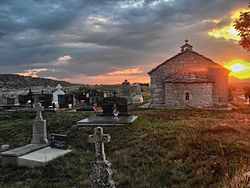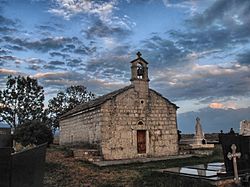| Church of St. Nikola | |
|---|---|
Црква светог Николе | |
 Church of St Nikola (Dobrelja) | |
| 43°04′57″N18°36′24″E / 43.082624°N 18.606654°E | |
| Location | Gacko |
| Country | Bosnia and Herzegovina |
| Denomination | Serbian Orthodox Church |
| History | |
| Dedication | St. Nikola |
| Consecrated | 2001 |
| Cult present | St. Nikola |
| Architecture | |
| Heritage designation | National Monument |
| Designated | 14 June 2000 |
| Years built | 1884-1889 |
| Completed | 1889 |
| Specifications | |
| Materials | Limestone |
The Church of St Nikola is located in Dobrelja village, in Bosnia and Herzegovina, municipality of Gacko, Republic of Srpska entity. [1] The church was rebuilt between 1884 and 1889. The temple was consecrated in 2001. [2]













